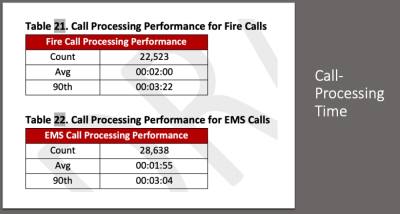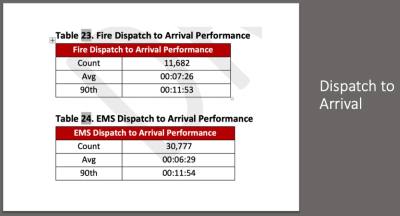“This whole discussion started with some issues in Precinct 3,” Fort Bend County Judge KP George said. “Every precinct has different needs and a different number of people living in it. Precinct 3 is more than 33% of Fort Bend County, and 95% of the people in Precinct 3 don’t live in a city. That means the county provides service to them.”
Bruce Moeller, a senior consultant with Fitch & Associates, said personnel in the Fort Bend County Sheriff’s Office were generally open and engaged and showed levels of morale that were higher than what is seen across the nation.
“[However], we did not get quite that same level of feedback from some of the users in the field—the fire service and EMS, in particular,” Moeller said. “The reason I point that out is this is not that unusual as a finding. This qualitative difference that you see in people’s perspective oftentimes can be driven by the different type of services being provided.”
Moeller explained that law enforcement handles calls in a significantly different way than the fire department and EMS handle calls.
“Sometimes, it is difficult to address all the perspectives, all of the concerns of different agencies because you’re really providing three different services,” he said.
One issue Moeller pointed out was that fire dispatch had, at the time of the study, one operator to six radio channels. EMS had one operator to one channel, and law enforcement had three operators and three channels.
“From out in the field, the individual fire departments on those different channels are happier and they like it better because any radio traffic is generally associated just with them,” Moeller said. “The problem is for the person in the dispatch center. The potential for a collision between a fire channel needing something and a second radio channel needing something at the same time ... can result in a safety issue.”
The study showed that EMS calls account for about 60% of incidents, while fire accounts for about 40% of incidents.
In one year, there were nearly 23,000 fire incidents reported.
“That volume of activity is not something that’s overwhelming for a single dispatcher, but this was set up over six channels, which is one of the things that caught our attention.”
Another area for improvement has to do with the amount of time it takes a dispatcher to process a call and push it out, Moeller said.
In Fort Bend County, the average processing time for fire calls is two minutes, and the average time for EMS calls is one minute and 55 seconds. However, fire and EMS departments are designed and evaluated at the 90th percentile. So rather than aiming to meet a certain target 50% of the time, as departments would using the average, the goal is to align with hitting the same time 90% of the time.
For the 90th percentile measure, Fort Bend County takes three minutes and 22 seconds to process fire calls and three minutes and four seconds to process EMS calls.
“Both at the average and at the 90th percentile, the performance here is not as strong as we would like to see it,” Moeller said. “It is taking longer to process calls.”
Part of this may have to do with the perspectives of law, fire and EMS. Law enforcement has no recommended guidelines, nationally. For fire and EMS there are recommended practices. Fire and EMS are generally more time sensitive.
When it comes to measuring the time from dispatch to arrival, the average response for fire is about 7.5 minutes and about 6.5 minutes for EMS. At the 90th percentile, response times are nearly 12 minutes for fire and EMS.
“In a county, especially where you have the geography that you do and areas that are unincorporated and less densely populated, you will have response times that are larger,” Moeller said.
To combat these issues, Fitch and Associates put together several critical-, high-, medium- and lower-priority recommendations.
At a high level, one category is that the chiefs need to get together to define clear process expectations. Another is that although the opportunity for collisions for the operator responsible for six channels is low, as the system gets busier, this needs to be condensed to one or two channels, Moeller said.
Then, call processing time can be addressed with a goal of hitting one minute and 30 seconds for dispatching at the 90th percentile. Some ways to shave down the time spent on dispatch calls is classifying calls as high- and low-priority better and working to tie the safety entities together so residents calling in are not asked the same questions multiple times, Moeller said.
“I’ll be blunt, 90-95% of the time 911 calls do not need that level of speed, but for the five or 10%, they do,” he said.
Commissioners Court will officially vote on whether to move forward with these recommendations at the Feb. 11 meeting.
“I see issues; I do,” George said. “I hope every one of us can get together and put one thing in focus: Our citizen’s safety.”







